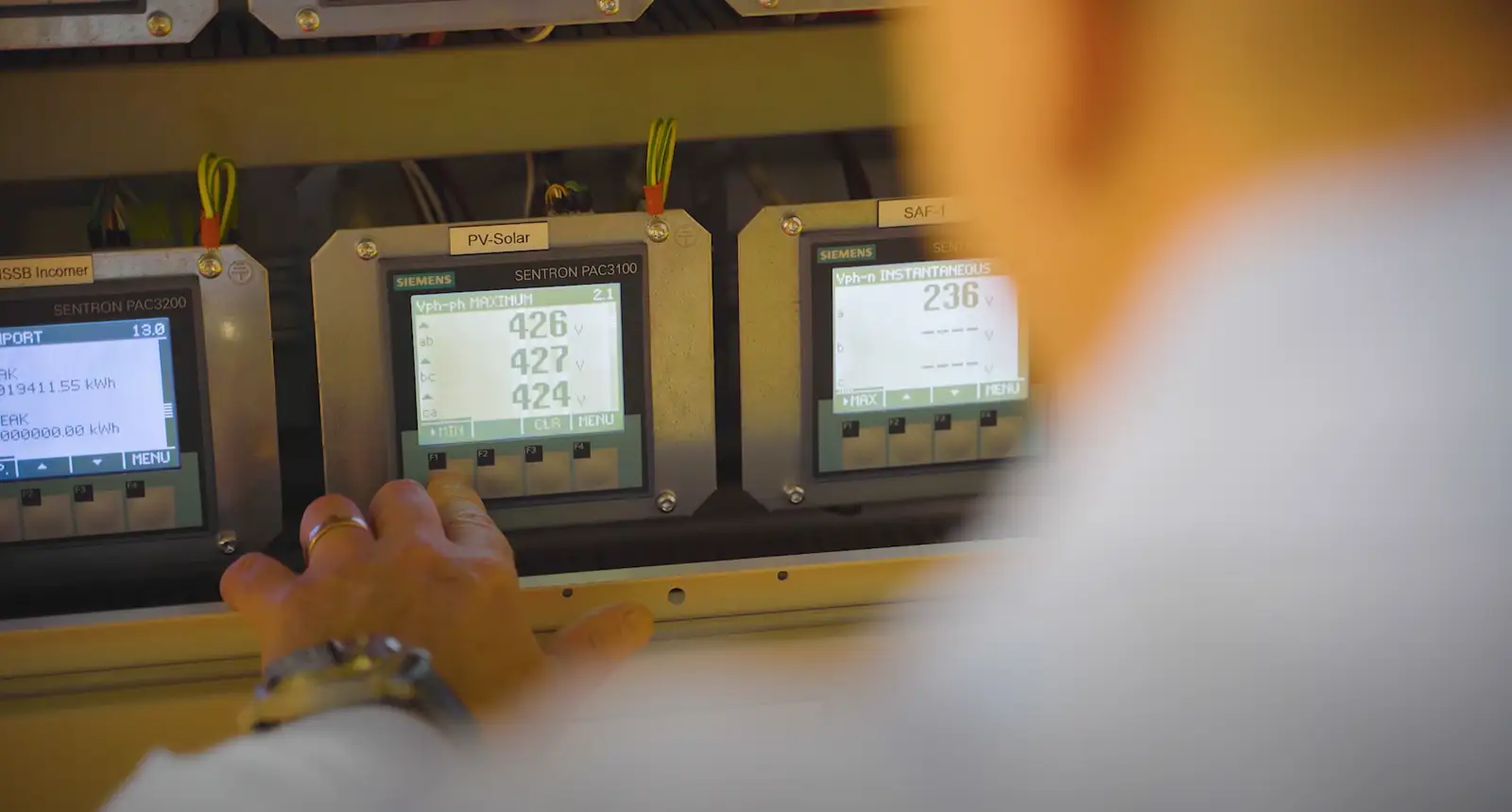Auckland commercial property investors Samson Corporation Group purchased the Axis building – formerly the Nestle chocolate factory - in the late 1980s. Now a multi-tenanted and multi-use business and residential property, the architecture of the building meant it was a great option for a green overhaul.
Property Sustainability Manager Bridget Pyc says retrofitting older buildings like Axis aims to enhance neighbourhoods, improve occupant well-being and productivity, and reduce the impact on the environment.
Each year New Zealand’s commercial buildings produce 750K t of carbon emissions with the sector making up 21% of New Zealand’s electricity use - costing businesses $800 million every year.
Commercial buildings primarily heat their spaces and water with coal, diesel, and gas. Reducing the demand for these fossil fuels offers a key opportunity to both reduce building operational costs and emissions in a commercial building. Operational carbon emissions come from everyday processes – like heating, cooling, and lighting.
There's a recognition that people, generally, do want to do the right thing when it comes to sustainability. We want to make that as easy as possible for them to do that within our buildings.
Playing the long game
Samson has invested in commercial buildings in Auckland since the 1940s and they have a sustainability strategy made up of four key drivers - innovation, responsibility, efficiency, and tenant engagement.
“The Samson Corporation thinks in generations not decades. I think that encapsulates it quite well. Being a family business, there has been long term thought for efficiency which has automatically translated into sustainability,” says Bridget.
The Samson team initially focussed on developing new buildings. They are responsible for New Zealand’s first five-star green star building, the Iron Bank on Karangahape Road, followed by the Geyser in Parnell, the first six-star green star building. Those successes highlighted the opportunity for sustainable retrofits across the existing buildings within their portfolio.
“We looked across buildings that had a heritage overlay, our smaller buildings or mixed-use spaces, and thought about how we could take the learnings and principals from our newer developments across the portfolio,” says Bridget.

Taking the first step
The team started by measuring their office’s operational carbon emissions - from travel to the waste output and electricity. They soon levelled up to ensure there was a wider impact by working with Toitū to look at the entire portfolio.
Using measurement tools NABERSNZ and carbonzero, the team assessed, benchmarked and improved property performance across their buildings. This approach has enabled them to set and meet significant sustainability targets as well as achieve and maintain Toitū net carbonzero certification.
The place Samson found had the biggest impact was through their tenant occupied spaces. This included everything from the internet and utilities to the refrigerant systems, the energy sources provided on site and tenant waste from day-to-day operations in the environment.
“We looked at our built environment spaces leased to tenants and at what we have operational control over. The waste coming out of the sites and from a tenant perspective, the electricity in the common areas and the fossil fuels that are being purchased or used on sites,” says Bridget.
“Seeing what is performing better in terms of carbon emissions means we make changes in a way that's going to future proof us, work for the tenants and be a thriving environment for people to be in.”
Bridget and Marco’s advice for businesses starting on their decarbonisation journey
- Get started – while initially it can seem like a daunting prospect, once you get the right advice and right people involved it becomes fairly straight forward.
- Love your data - there's a plethora of awesome tools out there to start measuring your emissions so to dig and find someone in the team who is interested in the data and get numbers on the page. It’s easy to start making some decisions and actions from there.
- Every building is different – determine what the key carbon emitting parts of your business are and try to be a leader in innovating to do something about it.
- Get your tenants on board – active engagement is key to bringing tenants along on the decarbonisation journey. Communicating what you are doing to create sustainable built environments and what your expectations are will help maximise the co-benefits for you, your staff, and clients.
The power of collaboration
The team made a goal to achieve net zero by 2030 across their entire portfolio and quickly found that it was something they could achieve sooner by bringing tenants along on the sustainability journey.
“This was something that tenants were asking for. Businesses wanted to operate within a sustainable built environment. Actively engaging tenants and building managers in the process was the key to reducing emissions and increasing energy efficiency,” says Bridget.
Bridget explains how measuring the carbon emissions right across the portfolio – with tenant buy-in – enabled the team to see what elements within each were performing better and where improvements could be made.
“We want it to be as simple as possible for people to jump on board and reduce emissions alongside us.”
To enable wider change within their buildings, one of the mechanisms Samson incorporated was the development of a building user guide.
Bridget says the building user guide, or ‘green lease’, signalled to tenants a partnership and outlined how they can get the most out of the environment.
“When we invite someone into the space, we set up an agreement of how we are going to work together in the sustainable built environment and what our expectations are. I ask what sustainability means for them and explain how we can maximise our allocations together.”
“It’s about how the tenant can increase the benefits of the space by sharing these values with clients, staff, cleaners and other guests - so that we're all on the same page throughout the tenancy,” says Bridget.
Samson and the chocolate factory
Axis was the last building for Samson to retro fit as the team thought it was going to be the hardest given the diversity of inefficient heating and cooling systems and number of tenants, but it turned out to be the easiest!
The project manager Marco Creemers says one of the biggest and most impactful changes the team made at the Axis building was removing the gas supply and replacing the existing air conditioning condensing ring main with a variable refrigeration flow system. The computerised system pumps a refrigerant to the tenancies instead of cool water.
“It’s all on demand so we don’t get any wasted energy as its not running all the time. It’s much more efficient for heating and cooling than gas,” says Marco.
The system is housed in a control room where temperatures and any variations are pre-set – saving wasted energy and electricity.
Changing up the system meant removing the incumbent heating from the building’s residential apartments and commercial tenancies as well as replacing all the ovens, pumps, and stoves with electric induction cooking.
But that wasn’t the biggest challenge.
“To cater to the new power loads, we had to upgrade the transformer through Vector, which was expensive and time consuming, as well as it required a building consent which stalled us for a bit.”
Some of the surprise learnings when the team started to look at their decarbonisation journey was the impact of refrigerants.
“While air conditioning and HVAC systems are efficient in terms of energy consumption, we do have a lot of liabilities sitting within those units in terms of refrigerant leaks. “Implementing a strong programme of maintenance and repairs on that as well as our communications programme around refrigerants has been a big focus for us as part of that learning.”

Benefits for all
The work has made a major difference to the carbon footprint of the Axis building. Pre-retrofit, the carbon emissions were 80T CO2 per year. This number was reduced to 10T CO2 per year post decarbonisation.
There have been some major co-benefits to the business in decarbonising the Axis building. Number one is the positive feedback from tenants.
Bridget says the comfort levels within the building have improved significantly and alongside that both Samson and their tenants have seen operational cost reductions.
“Where we've been proactive in replacing the likes of a gas boiler with an efficient system and providing solar panels there has been a decrease in the energy cost component.
“For tenants, there is an efficiency side to how the system performs but then also means that that's less dollars that gets spent on their energy output.”
Where Samson has decarbonised, moved old legacy equipment, and replaced it with efficient technology they have seen other gains as well.
“From a manager’s perspective it is easier to diagnose problems and be at the forefront of those potential tenant complaints or queries,” says Bridget.
The future of commercial buildings is low emissions
By encouraging collaborative, proactive solutions to sector-wide challenges, the Commercial Buildings Decarbonisation Pathway aims to take the learnings from others to help reduce the impact of the sector on the climate, while also reducing costs and ensuring future business continuity in a low emissions environment.
Eager to widen their scope of how they can influence the built environment, Samson is planning for how to create a more circular economy in the future.
“We need to consider in more detail how our tenant and contractor movements can contribute to emissions and consider how we better use the resources within each space to make sure that we keep materials and flow as much as possible,” says Bridget.
EECA’s Commercial Buildings Decarbonisation Pathway is supporting New Zealand commercial building owners and facilities managers in their transition to a low emissions business. The pathway is also helping to futureproof against climate change and the challenges that the industry is collectively facing.
Read next
-
Commercial Buildings Decarbonisation Pathway
Free tools and resources to help commercial building owners and managers reduce energy related emissions and increase efficiency.
-
Hot water heat pumps in commercial buildings
Information for businesses looking for a low-emissions solution to meet hot water and space heating requirements.
-
Commercial-scale solar in New Zealand
Should your business invest in commercial-scale solar? Our analysis shows a wide range of internal returns on investment – and this report gives the business sector a guide about how to accurately forecast financial returns.
